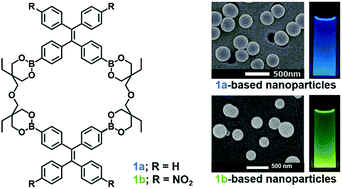当前位置:
X-MOL 学术
›
J. Mater. Chem. C
›
论文详情
Our official English website, www.x-mol.net, welcomes your
feedback! (Note: you will need to create a separate account there.)
Formation of emissive nanoparticles from tetraphenylethylene-containing boronate macrocycles: preparation, characterization and functionalization†
Journal of Materials Chemistry C ( IF 5.7 ) Pub Date : 2018-09-27 00:00:00 , DOI: 10.1039/c8tc03748e Mitsuki Hoshi 1, 2, 3, 4, 5 , Naoyoshi Kaneko 1, 2, 3, 4, 5 , Ryuhei Nishiyabu 1, 2, 3, 4, 5 , Yuji Kubo 1, 2, 3, 4, 5
Journal of Materials Chemistry C ( IF 5.7 ) Pub Date : 2018-09-27 00:00:00 , DOI: 10.1039/c8tc03748e Mitsuki Hoshi 1, 2, 3, 4, 5 , Naoyoshi Kaneko 1, 2, 3, 4, 5 , Ryuhei Nishiyabu 1, 2, 3, 4, 5 , Yuji Kubo 1, 2, 3, 4, 5
Affiliation

|
[2+2] Macrocycles composed of two tetraphenylethylenes (TPEs) and two linkers, namely 1a (R = H) and 1b (R = NO2), were prepared in a facile manner through the one-pot dehydration of gem-di(boronic acid)-appended TPEs 2a (R = H) and 2b (R = NO2) with di(trimethylolpropane) 3 in MeOH. Considering that use of THF instead of MeOH as the reaction solvent gave a mixture of boronate esters, hydrophobicity-induced non-covalent interactions involving mono(boronate ester) intermediates produced by the dehydration of 2 and 3, may be responsible for the selective cyclization in MeOH. We found that these boronate macrocycles formed emissive nanoparticles of 1a (λem = 483 nm, λex = 365 nm, ΦF = 31%) and 1b (λem = 539 nm, λex = 365 nm, ΦF = 11%) in H2O, with average diameters of 312 ± 44.6 nm and 146 ± 25.5 nm, respectively. The dynamic features of these particles endow them with reversible thermoresponsive properties; indeed, emissiveness responded linearly to temperature over the tested range. The hysteresis-free temperature sensitivity (S) of the 1a-based nanoparticles was determined to be 0.75% K−1 in H2O. Such behavior was rationalized by dynamic light scattering (DLS) experiments, which facilitated the detection of particle-size changes in response to temperature. As a control, bis(pinacolboryl)-appended TPE 6, which does not form nanoparticles in H2O, was poorly responsive to changes in temperature. Furthermore, effective emission quenching was observed upon addition of 2,6-dichloro-4-nitroaniline (DCN), a toxic pesticide, at a detection limit of 2.00 ppm in H2O/MeOH (3 : 2 v/v). Although DCN-induced quenching is ascribable to the nature of the TPE units, the self-assembled nanoparticle morphologies were altered upon addition of DCN, as determined by DLS and field-emission scanning electron microscopy (FE-SEM), and appeared to involve an Ostwald ripening process.
中文翻译:

由含四苯基乙烯的硼酸酯大环化合物形成发射性纳米粒子:制备,表征和功能化†
[2 + 2]环化合物2个tetraphenylethylenes体(TPE)和两个连接体,即构成1A(R = H)和图1b(R = NO 2),是在以容易的方式通过的一锅煮脱水制备宝石-二(含硼酸的TPE 2a(R = H)和2b(R = NO 2),含在甲醇中的二(三羟甲基丙烷)3。考虑到使用THF代替MeOH作为反应溶剂可得到硼酸酯的混合物,疏水性诱导的非共价相互作用涉及通过2和3脱水制得的单(硼酸酯)中间体可能是在MeOH中选择性环化的原因。我们发现,这些硼酸酯的大环形成的发光纳米颗粒1A(λ EM = 483纳米,λ EX = 365nm处,Φ ˚F = 31%)和1b中(λ EM = 539纳米,λ EX = 365nm处,Φ ˚F = 11% )在H 2 O中,平均直径分别为312±44.6 nm和146±25.5 nm。这些颗粒的动态特性使它们具有可逆的热响应特性。实际上,在测试范围内,发射率与温度呈线性关系。无磁滞温度灵敏度(基于1a的纳米颗粒的S)在H 2 O中确定为0.75%K -1。这种行为通过动态光散射(DLS)实验得到了合理化,这有助于检测响应温度的粒径变化。作为对照,在H 2 O中不形成纳米颗粒的双(频哪硼硼烷基)-附加的TPE 6对温度变化的响应较差。此外,在H 2中的检出限为2.00 ppm时,加入有毒农药2,6-二氯-4-硝基苯胺(DCN)可观察到有效的发射猝灭。O / MeOH(3∶2 v / v)。尽管DCN诱导的淬灭归因于TPE单元的性质,但通过DLS和场发射扫描电子显微镜(FE-SEM)的测定,添加DCN后,自组装纳米颗粒的形态发生了变化,并且似乎涉及奥斯特瓦尔德成熟过程。
更新日期:2018-09-27
中文翻译:

由含四苯基乙烯的硼酸酯大环化合物形成发射性纳米粒子:制备,表征和功能化†
[2 + 2]环化合物2个tetraphenylethylenes体(TPE)和两个连接体,即构成1A(R = H)和图1b(R = NO 2),是在以容易的方式通过的一锅煮脱水制备宝石-二(含硼酸的TPE 2a(R = H)和2b(R = NO 2),含在甲醇中的二(三羟甲基丙烷)3。考虑到使用THF代替MeOH作为反应溶剂可得到硼酸酯的混合物,疏水性诱导的非共价相互作用涉及通过2和3脱水制得的单(硼酸酯)中间体可能是在MeOH中选择性环化的原因。我们发现,这些硼酸酯的大环形成的发光纳米颗粒1A(λ EM = 483纳米,λ EX = 365nm处,Φ ˚F = 31%)和1b中(λ EM = 539纳米,λ EX = 365nm处,Φ ˚F = 11% )在H 2 O中,平均直径分别为312±44.6 nm和146±25.5 nm。这些颗粒的动态特性使它们具有可逆的热响应特性。实际上,在测试范围内,发射率与温度呈线性关系。无磁滞温度灵敏度(基于1a的纳米颗粒的S)在H 2 O中确定为0.75%K -1。这种行为通过动态光散射(DLS)实验得到了合理化,这有助于检测响应温度的粒径变化。作为对照,在H 2 O中不形成纳米颗粒的双(频哪硼硼烷基)-附加的TPE 6对温度变化的响应较差。此外,在H 2中的检出限为2.00 ppm时,加入有毒农药2,6-二氯-4-硝基苯胺(DCN)可观察到有效的发射猝灭。O / MeOH(3∶2 v / v)。尽管DCN诱导的淬灭归因于TPE单元的性质,但通过DLS和场发射扫描电子显微镜(FE-SEM)的测定,添加DCN后,自组装纳米颗粒的形态发生了变化,并且似乎涉及奥斯特瓦尔德成熟过程。





















































 京公网安备 11010802027423号
京公网安备 11010802027423号